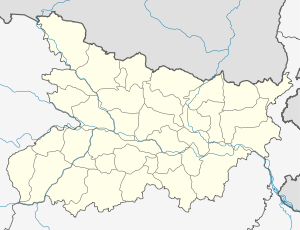Mahishi
| Mahishi महिषी مہیسی | |
|---|---|
| Village | |
 Mahishi Location in Bihar, India  Mahishi Mahishi (India) | |
| Coordinates (Mahishi): 25°51′16″N 86°27′54″E / 25.8543767°N 86.4650201°ECoordinates: 25°51′16″N 86°27′54″E / 25.8543767°N 86.4650201°E | |
| Country |
|
| State | Bihar |
| District | Saharsa |
| Elevation | 47.0 m (154.2 ft) |
| Population (2011) | |
| • Total | 19,073 |
| Time zone | UTC+05:30 (IST) |
| PIN | 852216 |
| Telephone code | 06478 |
| ISO 3166 code | IN-BR |
| Vehicle registration | BR |
| Sex ratio | 900 females per 1000 males ♂/♀ ♂/♀ |
| Language | Hindi, Maithili, Urdu |
| Additional language | English |
Mahishi is a Village with population of about 19 thousand is Mahishi sub district's the most populous village, located in Mahishi sub district of Saharsa district in the state Bihar in India. Total geographical area of Mahishi village is 28 km2 and it is the biggest village by area in the sub district. Population density of the village is 685 persons per km2.↵Nearest railway station is Saharsa. Nearest town of the village is Saharsa and distance from Mahishi village to Saharsa is 17 km. The village has its own post office and the pin code of Mahishi village is 852216. The village comes under Mahishi South, Mahshi North panchayat. Mahishi is the sub district head quarter and the distance from the village is 6 km. District headquarter of the village is Saharsa which is 17 km away. [1]The place is connected by boath roadways and railways.
History
Mahishi a small town mentioned by Adi Sankaracharya in his book for his debate with Maṇḍana Miśra, and his wife Ubhay Bharti in 8th Century(BC). Maṇḍana Miśra, who was leading a householder's life (Grihastha), to debate the merits of their respective schools of thought.[16] While trying to find the house of Maṇḍana, Sankara asked for directions and was told the following:
You will find a home at whose gates there are a number of caged parrots discussing abstract topics like — 'Do the Vedas have self-validity or do they depend on some external authority for their validity? Are karmas capable of yielding their fruits directly, or do they require the intervention of God to do so? Is the world eternal, or is it a mere appearance?' Where you find the caged parrots discussing such abstruse philosophical problems, you will know that you have reached Maṇḍana's place.
Debate took place in the Mahishi village, Maṇḍana Miśra and his wife got defeated. After defeat, he started life as a Mīmāmsaka, but changed his name and became a sannyāsin and an Advaitin. Maṇḍana Miśra, who was a contemporary of Shankara, may have been more influential in the Advaita Vedanta tradition than is usually acknowledged.Mahishi is also the village of great Maithili and Hindi writer Rajkamal Choudhary.
Demographics
The village is home to about 19 thousand people, among them about 10 thousand (53%) are male and 9035 (47%) are female. 81% of the whole population are from general caste, 19% are from schedule caste and 0% are schedule tribes. Child (aged under 6 years) population of Mahishi village is 18%, among them 52% are boys and 48% are girls. There are 3842 households in the village and an average 5 persons live in every family. In Mahishi village population of children with age 0-6 is 3522 which makes up 18.47 % of total population of village. Average Sex Ratio of Mahishi village is 900 which is lower than Bihar state average of 918. Child Sex Ratio for the Mahisi as per census is 927, lower than Bihar average of 935.[2]
Population of the village has increased by 37.1% in last 10 years. In 2001 census total population here were about 14 thousand. Female population growth rate of the village is 35.6% which is -3% lower than male population growth rate of 38.6%. General caste population has increased by 31.7%; Schedule caste population has increased by 65.2% and child population has increased by 51% in the village since last census.
Literacy rate (children under 6 are excluded) of Mahisi is 64%. 74% of male and 53% of female population are literate here.
Economy
Mahishi has 29% (5606) population engaged in either main or marginal works. 46% male and 11% female population are working population.